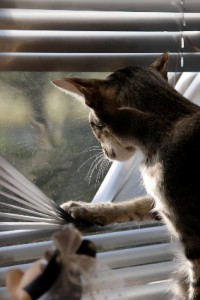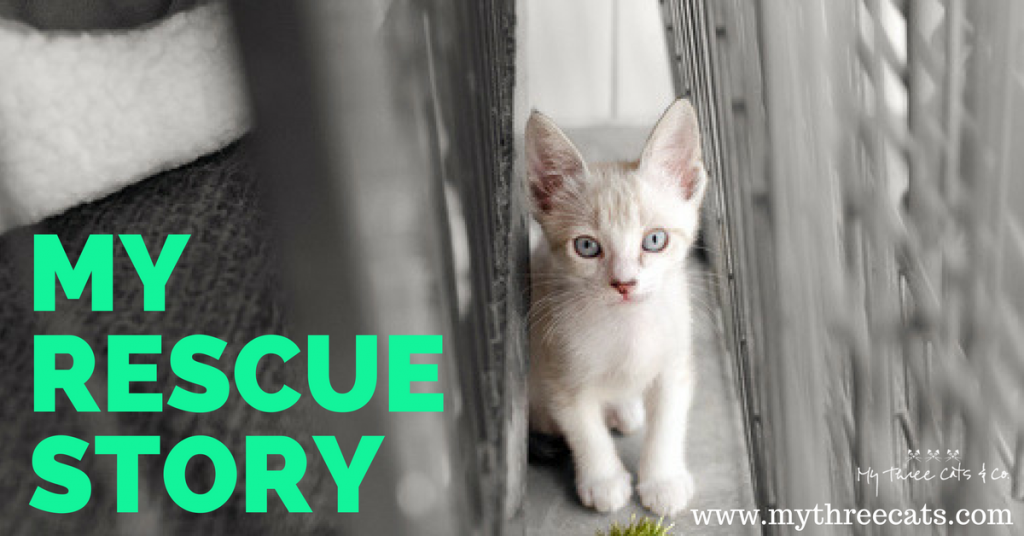MyThreeCats.com was named an expert in a Rent.com article. Check out the featured article: 4 Tips For Choosing Cat-Friendly Holiday Decorations| Rent.
Rent is a subsidiary of Redfin.com
Category: cat safety
Feline Adventures: Tips To Make Traveling With Your Cat A Real Treat
No one likes to leave their fur babies at home. This applies whether they go away on vacation, for the holidays or even for a quick get-away weekend. Even if you have pet-sitter extraordinaire caring for kitty, you know she gets lonely for you and only you. So what’s a good pet parent to do? Take her with you, of course! Travel with your cat!
According to the Roanoke Times, 78 percent of Americans travel with their pets each year. That’s a lot of people and animals taking to the road and airways!
Travel Tips
Traveling with any animal can be challenging. Fortunately, MyThreeCats.com offers easy solutions. We want to make your trips relaxing, safe, and even loads of fun for both your human and your furry feline friend.
Keeping your beloved pet safe is always your priority so a sturdy, durable cat carrier is a must for short day trips to the veterinarian or long rides to your family cabin or favorite beach. Your cat will love the new Expandable Cat Carrier with its foldaway canopy and poly lounge pad that makes it paw-sible for her to stretch out and get comfortable for the ride! You will love the lightweight, stylish carrier that folds flat for storage and travel, making it both attractive and functional. Take a close look at this innovative new Carrier.
So, you’ve reached your destination! Now, how do you keep your cat both safe and happy? She’s meowing up a storm to get out of the carrier and explore her new surroundings, but you can’t just let her have the run of the beach. Problem solved! She can be safe both indoors and outdoors playing in her durable Portable Cat Playpen that’s a breeze to set up and folds flat to fit back into its convenient travel bag. Durable polyester and mesh vents allow your pet to enjoy fresh air. Plus she has a purr-fect view of all the tempting creatures outside as she does at home in the front yard. It’s available in two sizes so dogs can also enjoy it and the rousing attention from onlookers walking their envious pets nearby.
You’ve been traveling all day and like you, your feline companion is ready for a nice long cat nap! Her portable cat playpen is now folded and safely stored in the car. You’ve reached your destination, so she is now meowing loudly, reminding you that it’s time for her favorite hideaway, the Lucy Cat Cave (mythreecats.com).
The lightweight home is shaped like a cone with a comfortable, washable cushion. Easily rolled up for travel, the cave serves like a familiar “mobile home” wherever your travels take her. As with all furniture featured at MyThreeCats.com, the Lucy Cat Cave is designed to blend with any home décor. See more luxurious and charming cat cave designs at Luxury Cat Beds for Sale | Quality Cat Hideaway Beds (mythreecats.com)
So, plan your next trip and pack your car! Kitty is excited about his next excursion, and with help from mythreecats.com, you can be, too! Don’t be surprised if she creates her own travel blog!
Vet Trips Made Easier
 Amy D. Shojai is a certified animal behavior consultant and the award-winning author of 23 pet care books, including “Complete Kitten Care” and “Pet Care in the New Century: Cutting-Edge Medicine for Dogs & Cats.” View more about Amy by clicking here:
Amy D. Shojai is a certified animal behavior consultant and the award-winning author of 23 pet care books, including “Complete Kitten Care” and “Pet Care in the New Century: Cutting-Edge Medicine for Dogs & Cats.” View more about Amy by clicking here:
https://www.thesprucepets.com/amy-shojai-cabc-551736
________________________________________
Cats get the short end of the health care stick. According to the American Veterinary Medical Association, cats visit the vet much less frequently than dogs. It’s not that felines are healthier (although cats do hide illness better) but many cats hate the vet so much their owners find it easier to just skip it. But even healthy cats need well exams once or twice a year.
Cats are adept at protecting themselves from stranger danger. What’s familiar is safe, while anything new or different raises kitty suspicions. A vet visit delivers a triple whammy by changing the cat’s routine, environment and exposure to strangers. Here are seven reasons cats hate the vet and how you can ease the angst.
Negative Crate Expectations. Cats learn very quickly to recognize cause and effect. The appearance of the cat carrier prompts kitty disappearing acts if used only for vet visits. Make the carrier part of the furniture and add a fuzzy bed or catnip toys inside to create a pleasant association.
Claustrophobic Car Rides. Though humans can look out windows and know what’s happening, the cat’s-eye view from the carrier offers movement without warning. Odd sounds and being in a strange environment raise cat blood pressure and might even prompt motion sickness. Covering the view with a towel over the carrier’s door helps some cats. But simply taking Kitty for many short rides around the neighborhood (and never going to the vet!) followed by treats or games can diminish nerves.
Scary Smells. Cats experience much of life through their noses. The array of unfamiliar smells found in a hospital — antiseptic, strangers, other animal’s fear — can ramp up the kitty fright factor. A pheromone product like Comfort Zone with Feliway that can be spritzed on a towel inside the carrier can help soothe environmental stress.
Strange Pets. Nothing turns felines into hiss-terical claw monsters like barking dogs or meowing cats. When confined inside a carrier, your frightened cat can’t flee, so the fight-or-flight instinct has no outlet. She may redirect her fear aggression on the nearest target — you or the vet staff. Ask to schedule your cat’s exam early in the morning or at slow times to avoid a busy waiting room. Some vet practices have separate waiting rooms and entrances for cats and dogs, so at least your cat never has to see or hear the mortal enemy.
Cold Exam Tables. Though cats may hate getting into their carriers, being dumped on a cold metal table elevates the “strangeness” of the experience significantly. After all, Kitty-Boy’s preferred lounging spots are the windowsill with a view, the soft top of the sofa, or a table underneath a warm lamp. Take along a towel or even the cat’s bed that smells like your cat to make the exam table more feline friendly. Some cat specialty practices have exam room windows with bird feeders outside or water fountains and fish tanks for kitty distraction.
Weird People Doing Weird Things. The vet and clinic staff love animals, but to your cat they’re from Mars. Maybe they wear uniforms and smell like dogs (spit!) and don’t ask permission to stroke his fur. A particular stressor is being handled by several people — the vet tech for getting a temperature or stool sample, for example, and later the veterinarian. Reducing the number of handlers may help. Scheduling enough time so the cat doesn’t feel rushed also can ease the tension.
Painful or Surprising Events. Needle sticks aren’t much fun. And a cold thermometer inserted into the nether regions is no way to make friends. It’s up to owners to offer treats or toys during and immediately after upsetting procedures to help change how cats feel about vet visits.
Cats remember discomfort, fear and bad experiences and expect them in the future. But they also remember good experiences and anticipate accordingly. Ask about taking your kitten for “fun visits” to meet and get used to the vet and staff, so he can simply play and be petted rather than examined and treated. Repeated happy visits take the scary out of the equation. Make vet visits more pleasant, and your cat will be happier — and healthier.
Bring out your indoor cat’s inner kitten with these easy ideas
Cats are intelligent, active creatures that need daily stimulation just like we do.
Help your cats to tackle boredom and keep undesirable behaviors to a minimum. Constant meowing, scratching furniture, and urinating outside the litter box are all behaviors that can be avoided with some simple solutions that will keep your feline companions entertained throughout the day.
- Put a well constructed multiple tiered cat tree next to your window that has a scratching surface such as sisal. They’ll happily gaze at birds, passing cars, and pedestrians. This is a simple activity that will occupy your cat for hours all year round.
- Turn on pleasant, easy going music or play a CD of nature sounds to soothe and comfort your pet when no one is home. Buy a cat sitter DVD with a continuous loop to entertain them.
- Satisfy your cat’s need to climb by creating safe pathways to the tops of bookshelves and other high places. If you have empty wall space, consider perch wall units that will accomplish this.
- Indulge the natural hunting instincts in your cat by hiding treats or dry kibble in your home. Use a kitty diner that will provide your cats with a stimulating activity. The challenging activity appeals to the natural love of hunting and will stimulate them mentally and physically. Change the locations frequently to keep things interesting.
- Give your cat new toys to sniff, play with, and explore. These might be anything from catnip toys, puzzle toys, teaser toys and tunnels. These are wise investments that will go a long way towards keeping your cat healthy and happy.
- Teach your cats to walk on a leash or provide a secure cat enclosure for the yard. This will enable your kitties to enjoy some of the perks of being outdoors without any of the risks associated with them roaming free outdoors.
- Treat your cat to quality one-on-one playtime and cuddle time as often as possible.
Your cats have a distinct personality just like you do, so why not try as many of these entertainment ideas as possible and stick to the ones they like best!
Shop at MyThreeCats.com and help support Alley Cat Allies
A sincere thank you from us and of course, the cats.



